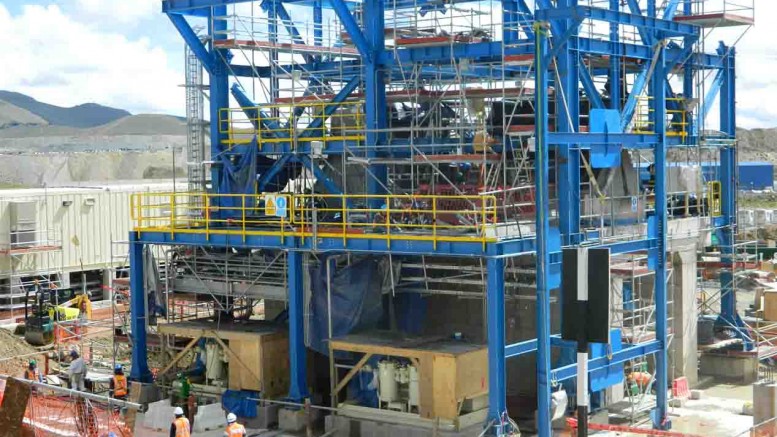As with many resource-rich developing countries, there can be tensions in Peru between pro-mining interests and affected local communities.
Switzerland-based Xstrata (XTA-L) is stuck in the middle of such a dispute as regional groups and Peru’s central government clash over environmental and social issues surrounding Xstrata’s Tintaya-Antapaccay copper project in the southern province of Espinar.
Protests around the city of Cuzco ignited in May as locals massed to demand that Xstrata increase funding for local-development initiatives. The movement ratcheted up a notch when protestors began calling for Tintaya’s closure due to negative impacts on the Salado and Canipia rivers.
Xstrata has denied environmental problems with the mine, and is in the process of a US$1.5-billion brownfield expansion program — called Antapaccay — slated to begin production in August.
“With regards to our environmental performance, our operations comply with all the requirements set forth by the law,” Xstrata said on May 28. “This has been demonstrated through the various monitoring processes conducted by competent agencies. In addition, we have publicly expressed our willingness to conduct additional participatory monitoring within the legal framework to clarify any perceptions or concerns that the population may have.”
The Antapaccay expansion holds total resources of 817 million tonnes grading 0.51% copper and is about 10 km from Tintaya. Xstrata expects the expansion to carry a 22-year mine life, and raise copper-in-concentrate production by 60% to 160,000 tonnes per year.
“The expansion and extension of operations at Tintaya provide important sustainable benefits for the regional communities,” Xstrata Copper’s CEO Charlie Sartain said. “We will be able to provide continued employment and training opportunities, important local infrastructure, benefits for local suppliers and enterprise development, additional royalty and tax revenues and investment in community projects and partnerships via the continuation of our voluntary contributions and the Tintaya Framework Agreement.”
Xstrata told Bloomberg News that it returns roughly 3% of its pre-tax profits from Tintaya — totalling US$11 million — to the province of Espinar each year. The company has voiced its willingness to renegotiate other aspects of its agreement with the province — such as the level of local employment — in hopes of promoting dialogue with regional leaders.
Peru’s central government has been critical of provincial fiscal practices, claiming lower level officials have been sitting on cash subsidies provided by international investment and using the funds inefficiently.
Peruvian President Ollanta Humala took office last year, and has been a staunch supporter of mining and foreign investment. A former military officer, Humala has dealt with a number of geopolitical incidences related to anti-mining campaigns in recent months, including disruptions at Newmont Mining’s (NMC-T, NEM-N) US$4.8-billion Minas Conga development and Southern Copper’s (SCCO-N) US$1.2-billion Tia Maria project.
Peruvian authorities declared a 30-day state of emergency in Espinar province following violent protests outside of Tintaya on May 31. Two protestors were killed, and dozens of police were injured. According to Peruvian state news agency Andina, the state of emergency allows national police a greater degree of freedom in dealing with the protests, including the suspension of constitutional rights relating to freedom of assembly.
Espinar Mayor Oscar Mollohuanca was arrested for “offenses against public order,” and sentenced to five months of preventive detention while he is investigated. Reports also said six other individuals thought to be associated with the protest were detained, though Peru’s state-run news agency did not release names or positions.
“Protests are to be peaceful and take place within the law,” Justice Minister Juan Jimenez said in a statement. “We are, however, entering into a period of very worrisome violence. We have a feeling that behind the environmental or community concerns there are political demands being made by radical groups, who want to bring into question investments being made in Peru.”
Meanwhile at a forum on economic development and capital markets in Lima, Peru’s Economy and Finance Minister Luis Miguel Castilla stressed the importance of finding a balance between stimulated growth and social peace. Peru is attempting to attract US$60-billion worth of potential natural resource investment over the next four years.
“Without social stability and social peace, it is going to be very difficult for investment flows to continue increasing,” Castilla said.
On May 29 Xstrata said that operations at Tintaya were running normally despite the state of emergency, and that the company was still capable of delivering shipments to port.
In addition to commissioning operations at its Antapaccay expansion later this year, Xstrata is in the engineering phase at its Las Bambas copper project in Peru’s northern Cotambamba and Grau provinces. Las Bambas has resources of 1.7 billion tonnes at 0.6% copper, as well as gold, silver and moly credits. The project is slated to cost Xstrata US$4.2 billion and yield average 400,000 tonnes of copper in concentrate, with operations projected to start in 2014.


Be the first to comment on "Xstrata copes with civil unrest in Peru"